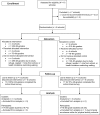The walking school bus and children's physical activity: a pilot cluster randomized controlled trial
- PMID: 21859920
- PMCID: PMC3164094
- DOI: 10.1542/peds.2010-3486
The walking school bus and children's physical activity: a pilot cluster randomized controlled trial
Abstract
Objective: To evaluate the impact of a "walking school bus" program on children's rates of active commuting to school and physical activity.
Methods: We conducted a pilot cluster randomized controlled trial among 4th-graders from 8 schools in Houston, Texas (N = 149). Random allocation to treatment or control conditions was at the school level. Study staff walked with children to and from school up to 5 days/week. Outcomes were measured the week before (time 1) and during weeks 4 and 5 of the intervention (time 2). The main outcome was the weekly rate of active commuting, and a secondary outcome was moderate-to-vigorous physical activity. Covariates included sociodemographics, distance from home to school, neighborhood safety, child BMI z score, parent self-efficacy/outcome expectations, and child self-efficacy for active commuting. A mixed-model repeated measures regression accounted for clustering by school, and stepwise procedures with backward elimination of nonsignificant covariates were used to identify significant predictors.
Results: Intervention children increased active commuting (mean ± SD) from 23.8% ± 9.2% (time 1) to 54% ± 9.2% (time 2), whereas control subjects decreased from 40.2% ± 8.9% (time 1) to 32.6% ± 8.9% (time 2) (P < .0001). Intervention children increased their minutes of daily moderate-to-vigorous physical activity from 46.6 ± 4.5 (time 1) to 48.8 ± 4.5 (time 2), whereas control children decreased from 46.1 ± 4.3 (time 1) to 41.3 ± 4.3 (time 2) (P = .029).
Conclusions: The program improved children's active commuting to school and daily moderate-to-vigorous physical activity.
Trial registration: ClinicalTrials.gov NCT00758615.
Figures
References
-
- Lee MC, Orenstein MR, Richardson MJ. Systematic review of active commuting to school and children's physical activity and weight. J Physical Activity Health. 2008;5(6):930–949 - PubMed
-
- Dietz WH. Health consequences of obesity in youth: childhood predictors of adult disease. Pediatrics. 1998;101(3 pt 2):518–525 - PubMed
-
- Physical Activity Guidelines Advisory Committee Physical Activity Guidelines Advisory Committee Report. Washington, DC: US Department of Health and Human Services; 2008
Publication types
MeSH terms
Associated data
Grants and funding
LinkOut - more resources
Full Text Sources
Medical


